

Switchback Travel (Jason Hummel)
As your main line of defense against snow and wind, a quality snowboard jacket is a key piece of your kit. Designs fall into three basic categories: versatile and light shells, insulated models for a boost in warmth, and 3-in-1 jackets that include a zip-out midlayer. Prices also vary, ranging from budget-oriented models that sneak in around $200 to technical, Gore-Tex-equipped pieces that cost $700 or more. Below we break down the best snowboard jackets for the 2025 season, which cover everything from resort and park favorites by popular brands like Burton and Quiksilver to uncompromising, premium designs for serious riders. For more background information, see our comparison tables and buying advice below the picks, along with details about our testing process. Of note: This article includes picks for both men and women, but we’ve also written dedicated round-ups of the best men's snowboard jackets and best women's snowboard jackets.
Editor's note: We updated this guide on March 18, 2025, to rework our recommendations to be more balanced between men's and women's designs. You'll now see our top picks for both genders, as well as information that more fairly represents their similarities and differences.We also revamped our buying advice section and incorporated photos from recent testing.
 Category: Insulated
Category: Insulated
Insulation: 60g PrimaLoft Silver
Waterproofing: 2L Gore-Tex
What we like: Sturdy protection, premium features, and high-quality build.
What we don’t: Not a standout in breathability or weight.
Burton’s AK line has a well-earned reputation for quality builds, and their men’s Swash and women’s Embark hit a nice balance of protection, comfort, and features. The lightly insulated jackets (the Swash has 60g PrimaLoft Silver only in the torso, while the Embark has 60g throughout) are built around a sturdy 2-layer Gore-Tex construction that shrugs off high winds and heavy precipitation, while the interior has a surprisingly plush and soft feel thanks to the mesh and stretchy taffeta lining. Tack on premium touches like a dedicated phone pocket that’s insulated to keep your battery fresh, pit zips, and mitten-friendly zippers, and it's easy to see why these Burton offerings earned our top spot for the 2025 season.
As with the rest of the AK collection, the Swash and Embark have fairly high price tags, and they’ll likely be overkill for occasional riders and those just getting into the sport. For beginners and fair-weather boarders, it's likely worth considering cheaper alternatives like Burton's own Covert or the women-specific 686 Athena below. At the other end of the spectrum, Arc’teryx’s Sabre/Sentinel series gets you improved breathability at a lighter weight, but with a serious jump in price. This brings us back to the Burton Swash and Embark, which strike a great combination of proven Gore-Tex protection for deep days, comfort and mobility for sidecountry hikes, and practical features for discerning riders. If you plan to get out on the slopes with any regularity, there's no doubt these Burton jackets will get the job done.
See the Men's Burton [ak] Swash GTX 2L See the Women's Burton [ak] Embark GTX 2L

 Category: Insulated
Category: Insulated
Insulation: 80g ThermacoreEco
Waterproofing: 2L Dryride
What we like: A wallet-friendly jacket that doesn't sacrifice much in the way of features or performance.
What we don’t: Decidedly less premium than the Swash above; we have concerns about long-term durability.
For casual boarders and those just getting into the sport, there's little need to spend up for premium tech and features. Thankfully, Burton has plenty of quality options available for less than the Swash above. Their $270 Covert 2.0 is a case in point: The 2-layer Dryride construction is durable and decently weather-ready, and the moderate dose of synthetic fill (80g ThermacoreEco) offers a nice amount of warmth for frigid temperatures without being totally overwhelming when the sun peeks out. You also get a nice assortment of features, including a removable powder skirt, fleece-lined hand pockets, pit zips, and Burton’s soft interior lining. Last but not least, we've big fans of the laid-back styling and appreciate that the design if offered in a healthy range of sizes and colorways.
What do you give up in going with a cheaper design like the Covert? Most notably, the design makes some compromises in long-term durability and wet-weather performance. The Dryride shell is a notable step down from Gore-Tex in all-out protection, and it doesn't help that the seams are only critically taped (premium designs like the Swash above have fully taped seams). It's also likely that the insulation will pack out over time, which is true of most budget designs. Committed riders who experience a lot of rain and heavy snow will likely want to upgrade, but if you set realistic expectations, we think the Covert nails the basics for those just starting out.
See the Men's Burton Covert 2.0 Jacket
 Category: Insulated
Category: Insulated
Insulation: 80g (body), 60g (sleeves), & 40g (hood) InfiLoft
Waterproofing: 2L InfiDry
What we like: A warm and affordable design from a well-respected brand.
What we don’t: Not well suited for particularly wet climates.
California-based 686 has a strong foothold in the snowboard jacket market, consistently hitting an excellent balance of price, performance, and styling. At the budget end is their women’s-specific Athena, which offers a basic but well-rounded feature set, a nice array of color options, and a cozy interior—all for an affordable $200. In terms of warmth, the jacket is moderately insulated with 80-gram (g) synthetic in the body and a less bulky 60g in the arms (an even lighter 40g is used in the hood). Another nice touch is the jacket’s generous storage layout—a common area that brands cut back on to save manufacturing costs: The Athena boasts a dedicated pass pocket on the sleeve (perfect for RFID cards), an interior phone pocket, a drop-in mesh pocket for goggles or gloves, and a key clip-equipped external chest pocket. Tack on pit zips and a powder skirt, and the Athena checks a whole lot of boxes for resort days.
Like the men's Burton Covert 2.0 above, the 686 Athena does cut a few corners to help keep costs down. Specifically, the jacket is only critically seam-taped, which doesn't inspire a ton of confidence in heavy, extended moisture (it's more likely that water will make its way through the exterior). The hood is also a little lacking in refinement—we found it tough to get a secure, batten-down-the-hatches feel due to the limited adjustability. But for those who get out in mostly favorable weather, the Athena is a perfectly capable entry-level option that looks good to boot.See the Women's 686 Athena Insulated
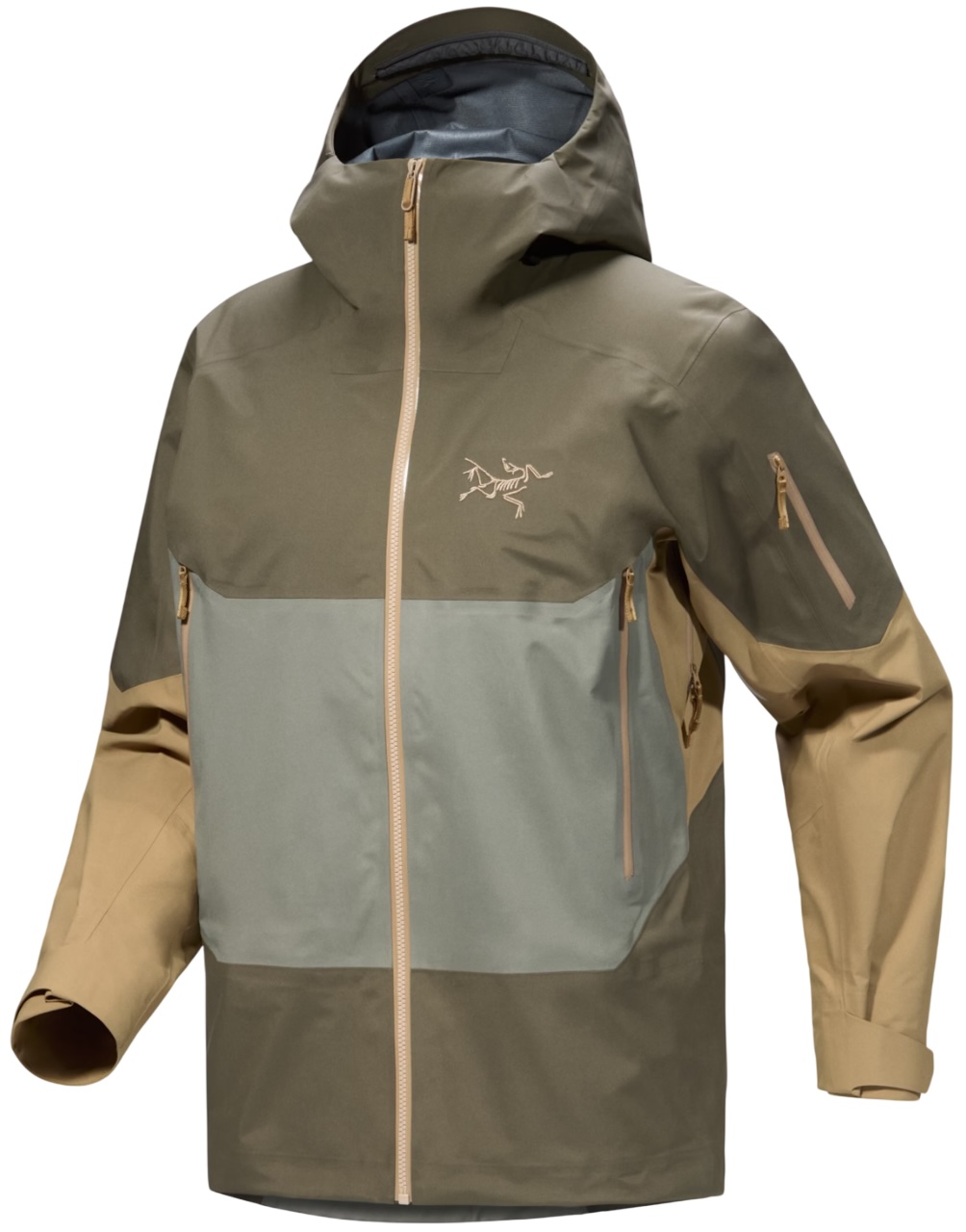 Category: Shell
Category: Shell
Insulation: None (flannel backer)
Waterproofing: 3L Gore-Tex ePE
What we like: Top-notch weather protection and durability for the resort and backcountry.
What we don’t: Expensive.
Serious snowboarders and splitboarders will get a lot out of a high-performing jacket like the Arc’teryx Sabre and women's Sentinel. This uninsulated, 3-layer Gore-Tex shell is purpose-built to handle wet and rowdy conditions, and it's lightweight and breathable enough for sidecountry forays and short trips into the backcountry. At the same time, the jacket is well built with an 80D shell fabric that's confidence-inspiring for frequent chairlift rides and fending off the occasional tree branch. And as we've come to expect from Arc'teryx, the Sabre and Sentinel are built with a keen attention to detail—we especially love the functional StormHood that offers great coverage and adjustability without impeding vision.
There's a lot to love about the Sabre and women's Sentinel, from their stalwart protection to smaller details like the soft flannel backer, which adds a nice dose of coziness and a touch of warmth. That said, $750 is a steep price to pay, and casual resort riders can save a lot by stepping down to a less streamlined 2-layer design. On the flip side, value-oriented backcountry-goers may want to consider a standard hardshell jacket, although you'll likely forgo helpful snow-specific features like a powder skirt and extended coverage. But for those who hit the slopes often and like to spend time both in and out of bounds, the Sabre and Sentinel are simply hard to beat. A final bonus: They utilize Gore's latest ePE membrane, which is free from harmful "forever chemicals."
Read more: men's Sabre review and women's Sentinel review (prior versions)
See the Men's Arc'teryx Sabre See the Women's Arc'teryx Sentinel
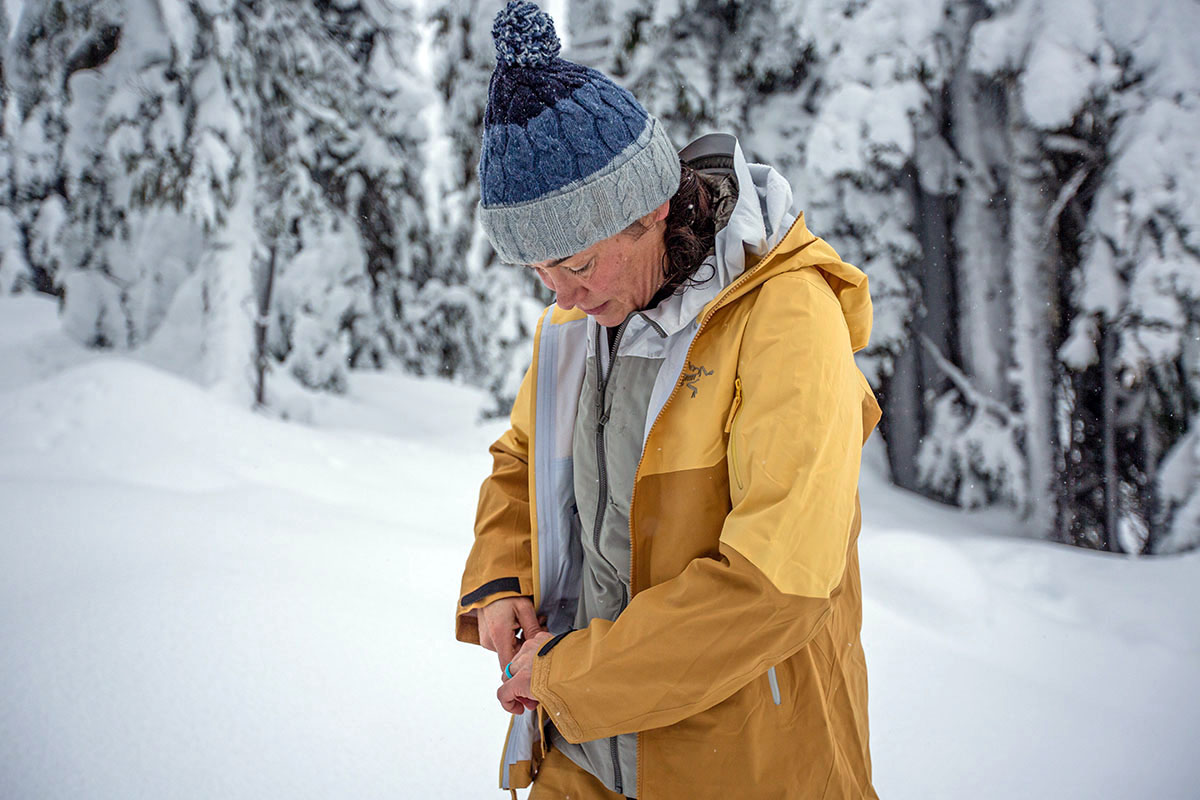
 Category: 3-in-1
Category: 3-in-1
Insulation: 160g InfiLoft (men's), 100g InfiLoft (women's)
Waterproofing: 2L InfiDry
What we like: A waterproof shell and insulated midlayer in one purchase.
What we don’t: Heavy, prone to drafts, and big differences between the men's and women's models.
3-in-1 snowboard jackets represent a strong value, combining two purchases—a shell and insulated midlayer—in one. Among the myriad options, 686's Smarty Form and women's Smarty Spellbound stand out for their well-rounded performance and thoughtful design choices. For a very approachable $200, you get a tough 2-layer shell that's effective at shedding moisture and combatting snags, along with a synthetic jacket that can be zipped in for warmth or removed when the mercury rises. Both models com equipped with ample storage (on both layers), underarm vents, fully taped seams, and a powder skirt for sealing out snow at the waist.
However, 3-in-1 designs come with some inherent trade-offs: The added zippers and snaps make them heavier and bulkier than standard insulated designs, and we've found that drafts can enter between the layers. 3-in-1s also tend to run warm, even with the midlayer zipped out. Finally, it's worth calling out a few key differences between the men's and women's styles: The men's Form uses 160g insulation throughout, while the Spellbound packs in thinner 100g with sherpa fleece covering the arms. The Form also includes stretchy side panels for improved mobility (which the Spellbound lacks), although the Spellbound tacks on a soft tricot lining along the collar. Finally, the Form's storage layout comprises five external and two internal pockets, while the Spellbound has three pockets on both the inside and outside. Ultimately, both jackets deliver strong performance for the price, earning them a spot high on our list this season.
See the Men's 686 Smarty 3-in-1 Form See the Women's 686 Smarty 3-in-1 Spellbound

 Category: Insulated
Category: Insulated
Insulation: 80g (body) & 40g (sleeves) Thermogreen
Waterproofing: 2L H2No
What we like: A high-quality insulated jacket for $100 less than the top-ranked Burton Swash and Embark.
What we don’t: Too warm for anything more than lapping groomers; fairly athletic fit.
Patagonia’s Insulated Powder Town lands in a real sweet spot: cheaper than the top-ranked Burton Swash and women's Embark but decidedly more premium than budget picks like the Covert and Athena. While Patagonia's in-house H2No membrane isn't quite up to Gore-Tex standards, we came away impressed by how well it held up to challenging conditions in British Columbia. We also enjoyed the moderate dose of insulation (80g in the body and 40g in the sleeves) and well-rounded feature set, including an adjustable hood, tall collar, powder skirt, and fully taped seams. All in all, if you like the sound of the Burton offerings but want to save a little cash, the Powder Town will get the job done without too many compromises.
However, the Powder Town's 2-layer, insulated construction limits it to groomers—we were quick to overheat during sidecountry trudges and when lapping the terrain park. Patagonia does offer an uninsulated variation for $349, but even that model can't match 3-layer competitors when it comes to breathability. A final downside worth calling out may not be one, depending on your styling preferences: The Powder Town fits on the more athletic end of the spectrum compared to most designs here, although we had no room fitting a lightweight down puffy underneath. If you don't mind the trimmer fit, it's a really high-quality resort piece.
Read more: women's Patagonia Insulated Powder Town review
See the Men's Patagonia Insulated Powder Town See the Women's Patagonia Insulated Powder Town
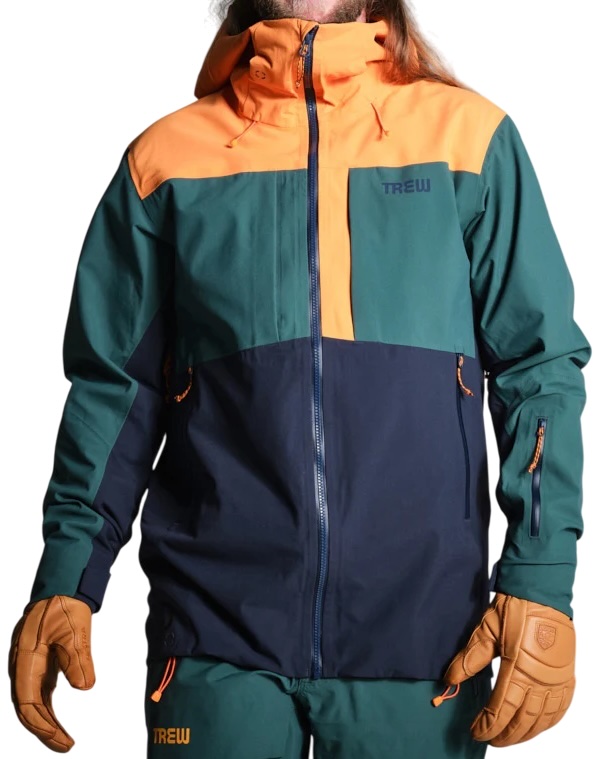 Category: Shell
Category: Shell
Insulation: None
Waterproofing: 3L PNW Primo
What we like: A highly protective and stylish 3-layer design that lines up well with premium competitors.
What we don’t: Overbuilt for dedicated backcountry riding.
Trew Gear's ski and snowboard apparel has been quick to win us over for its combination of clean styling and reliable performance, and their Cosmic and women's Stella Primo jackets are prime examples. For a significant $250 less than the Arc'teryx Sabre and Sentinel above, the Trew jackets stack up competitively well. Trew's in-house PNW Primo membrane is reminiscent of Gore-Tex in terms of protection, and the shell fabric is both robust and stretchy. Finally, we think Trew's styling is hard to beat, with both the Cosmic and Stella offering excellent coverage, a relaxed fit, and eye-catching colorways (including several two- and three-tone options that are very fun).
That said, while the Cosmic and Stella are highly competitive overall, they're not as well suited for backcountry use as the pricier Sabre and Sentinel. Both Trew jackets are relatively heavy for uninsulated shells (1 lb. 14.1 oz. for the Cosmic and 1 lb. 13.5 oz. for the Stella), so dedicated splitboarders will likely want to look elsewhere. To be fair, you do get pit zips for dumping excess heat, which we found to be decently effective on sidecountry jaunts. In the end, if most of your days are spent inbounds, the Cosmic and Stella are well priced for the level of performance they offer. A final note: While the two styles are largely the same, the women's Stella has 4-inch-shorter pit zips and features slanted (rather than vertical) hand pockets and extended cuffs.
Read more: men's Cosmic Primo review and women's Stella Primo review
See the Men's Trew Gear Cosmic Primo See the Women's Trew Gear Stella Primo
 Category: Insulated
Category: Insulated
Insulation: 80g (body) & 60g (sleeves)
Waterproofing: 2L Gore-Tex
What we like: Dependable protection and balanced warmth in a pretty affordable package.
What we don’t: There are some signs of cost-cutting.
Volcom’s L Insulated Gore-Tex shares some similarities with our top-tanked Burton Swash but for a considerable $100 less. Like the Swash, the L boasts a reliable 2-layer Gore-Tex construction but swaps in slightly thicker 80g synthetic insulation (the Swash uses 60g) for a modest bump in warmth. The L's styling is also more subdued, which may be a pro or a con depending on your preferences (we feel it's a little dull). We've come to like the well-executed storm hood that makes it easy to batten down the hatches, and Volcom's Zip Tech System—which connects the jacket to Volcom snowboard pants—is both easy to use and great at maximizing coverage. All in all, it's a pretty solid value from the California-based brand.
What do you give up by going with the Volcom L Insulated over the Burton Swash? In our experience, material quality is the biggest sacrifice: The L has a cheaper look and feel overall—the gym short-like mesh lining backing the underarm vents is one area where it's clear Volcom cut costs—and the cuff adjustments have a relatively flimsy feel. But our jacket has held up well thus far, and we appreciate that Volcom also offers the design in an uninsulated version for a little less.
See the Men's Volcom L Insulated Gore-Tex
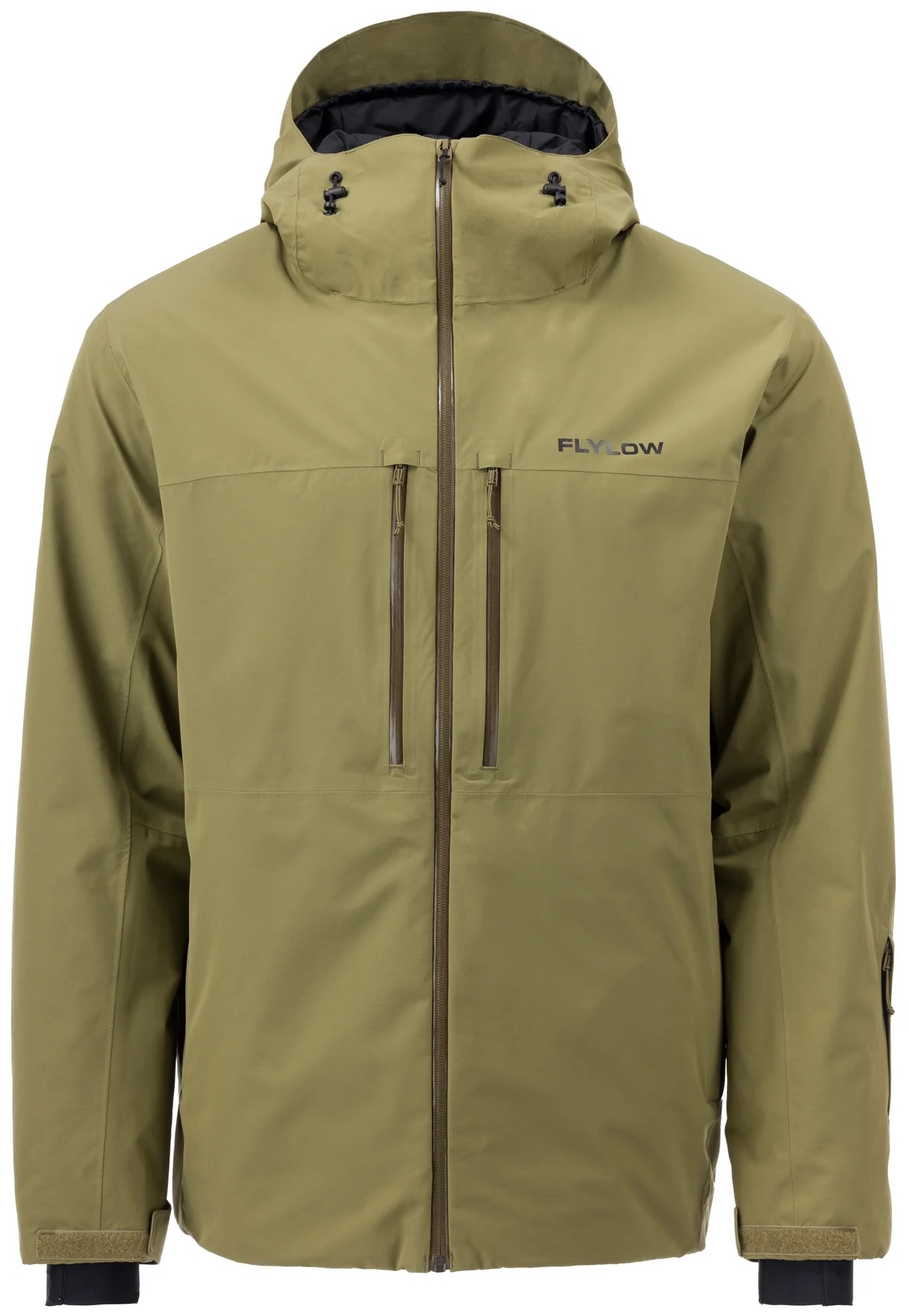 Category: Insulated
Category: Insulated
Insulation: 60g (men's), 100g (women's)
Waterproofing: 2L Lux
What we like: Warm, stylish, and easy to move in.
What we don’t: On the pricier end for a 2-layer jacket and not particularly durable.
Flylow Gear has risen to popularity very quickly—and for good reason. In addition to offering quality pieces at price points that consistently undercut the competition, Flylow pieces managed to look great in the process. For snowboarders, we especially like their Albert and women's Avery jackets. Comfort is a clear highlight of both designs, including a stretchy 2-layer shell that has a decent amount of "give," cozy synthetic insulation (60g throughout for the Albert and 100g with thinner 80g in sleeves and hood for the Avery), and nice touches like wrist gaskets and a baffled interior that's soft to the touch. The price is a little steep at $450 considering the 2-layer construction, but it's hard to knock Flylow's quality performance in a stylish, freeride-inspired package.
Like many other insulated jackets, the Flylow Albert and Avery will be overkill in warm spring weather. They also feature a relatively thin (40D) shell fabric, which isn't very confidence-inspiring for consistent resort use (for comparison, most competitors are around 80D or thicker). In testing the women's Avery Jacket, we experienced issues in the form of light pilling at the sleeves, wrists, and chest, along with a smattering of stains throughout. This was a bit of a letdown considering the price, although opting for a darker colorway will help minimize cosmetic wear.
See the Men's Flylow Albert Jacket See the Women's Flylow Avery Jacket
 Category: Insulated
Category: Insulated
Insulation: 60g ThermacoreEco
Waterproofing: 2L Dryride
What we like: Long cut lends style points and below-the-waist coverage.
What we don’t: Not well equipped for handling wet conditions; heavy and bulky.
There are several eye-catching designs to choose from on this list, but none can match the Burton Prowess 2.0 when it comes to flair. The most notable feature is the jacket's long cut, which extends down the thighs and back for excellent coverage and warmth below the waist. The trendy styling is rounded out with deep cargo pockets, wide cuffs, and a two-way front zipper that allows you to unzip from the bottom up to maximize mobility when sitting or bending over. The Prowess can hold its own on the mountain, too: Its 2-layer shell does a good job fending off moisture and abrasion, while the 60g ThermacoreEco synthetic fill effectively traps warmth. For reference, we've been getting a lot of use out of the Prowess—and not exclusively at the resort, since it makes a great around-town piece, too.
To be sure, the Burton Prowess 2.0 isn't a jacket for serious riders. For one, the long cut doesn't offer the level of mobility required for tackling tough lines, and the basic shell and critically taped seams leave vulnerabilities for moisture to enter. Not to mention, the Prowess is a lot of jacket, with a good amount of heft and bulk that make it difficult to pack down for travel or storage (it's noticeable while riding, too). But if you're on the hunt for a style-first design that can be worn both on and off the slopes, the Prowess is worth having on your radar.
See the Women's Burton Prowess 2.0 Jacket
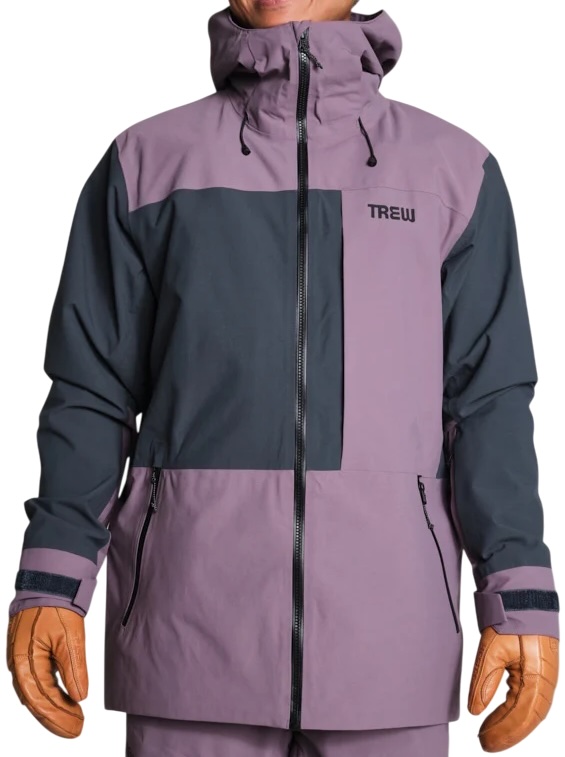 Category: Shell
Category: Shell
Insulation: None
Waterproofing: 2L PNW
What we like: A no-frills but decently high-performance design for resort riders.
What we don’t: Hefty and not particularly breathable.
Among Trew Gear's more affordable offerings is their Jefferson and women's Astoria. For just $329, these pieces offer well-rounded resort performance with similar styling to the premium (but much pricier) Cosmic and Stella Primo jackets above. The Jefferson and Astoria are 2-layer designs, which translates to reduced breathability and added bulk compared to 3-layer options like the Cosmic and Stella, but we found the in-house PNW membrane to be very reliable in the wet. The cheaper jackets also feature excellent coverage and very durable exteriors (200D x 320D) that provide a fortress-like feel in rowdy weather.
Overall, the Jefferson and Astoria check most of the boxes we look for in a quality resort companion, but they're a little lacking in refinement. They weigh about the same as most insulated designs on our list (1 lb. 14 oz. for the Jefferson and 1 lb. 12 oz. for the Astoria), and we found the bulk to be noticeable on the slopes, especially when the exterior starts to soak through (which only happened for us in heavy, extended rain). Finally, we didn't love the angled, flap-protected hand pockets on the women's version, which were difficult to access (the Jefferson's are sleeker and more functional). Gripes aside, the Jefferson and Astoria are excellent values for what you get, earning them a respectable finish on our list this season.
Read more: women's Trew Gear Astoria Jacket review
See the Men's Trew Gear Jefferson Jacket See the Women's Trew Gear Astoria Jacket
 Category: Shell
Category: Shell
Insulation: None
Waterproofing: 3L Gore-Tex & 2L Gore-Tex w/ Stretch Technology
What we like: Lightweight, breathable, and easy to move in without sacrificing protection.
What we don’t: Not a strong value.
The Sabre and Sentinel above cross over well between the resort and backcountry, but dedicated splitboarders who like to earn their turns will want something even lighter and more breathable. Enter Outdoor Research’s Hemispheres II, which meets this criteria with a scant, 1-pound-3.7-ounce build and massive TorsoFlo side vents that extend from the underarms all the way down to the hem. The Hemispheres also features a unique combination of 3-layer and 2-layer Gore-Tex with their Stretch Technology, resulting in a great balance of protection, breathability, and freedom of movement—the skin track trifecta. Rounding out the design is a functional feature set that includes mesh drop pockets for stashing skins and an athletic—but not overly trim—cut that offers great coverage.
However, while the Hemispheres isn't the priciest design here at $650, it's undeniably spendy and a step down from Arc'teryx's painstaking attention to detail. For a cheaper backcountry-ready option, OR's Skytour AscentShell Jacket ($429) comes equipped with their softshell-like AscentShell fabric, which is even more breathable and easier to move in than the Hemispheres but not as impervious-feeling. In the end, the Hemispheres is an undoubtedly high-tech design that's been a backcountry favorite of ours for years, but it doesn't stand out as a strong value.
Read more: men's OR Hemispheres Jacket review (prior version)
See the Men's OR Hemispheres II Gore-Tex See the Women's OR Hemispheres II Gore-Tex
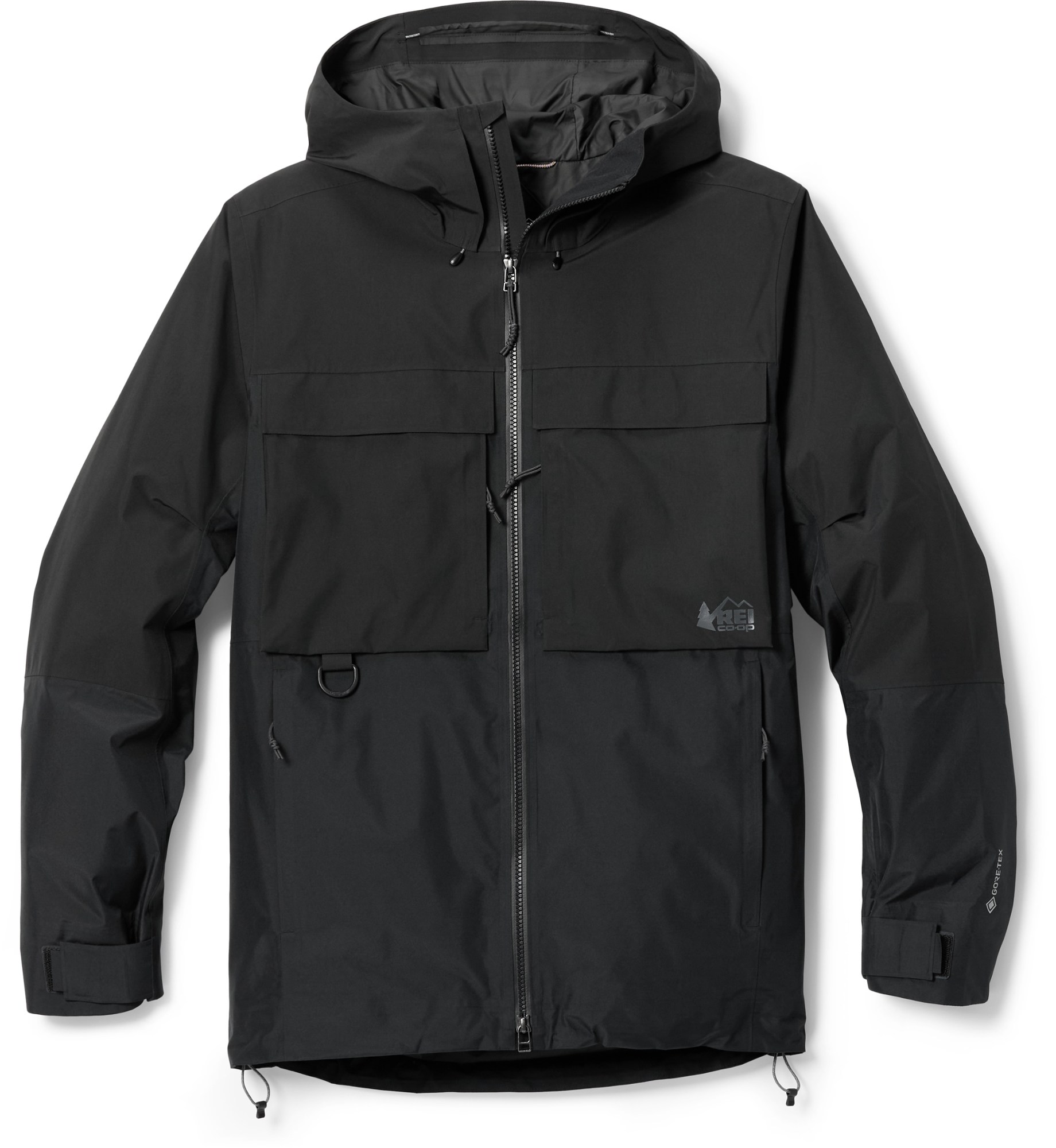 Category: Shell
Category: Shell
Insulation: None
Waterproofing: 2L Gore-Tex ePE
What we like: The cheapest Gore-Tex-equipped option on our list; fully featured.
What we don’t: A little lacking in refinement; not the most performance-ready 2-layer design here.
REI Co-op is well known for churning out affordable yet reliable outdoor apparel, and their First Chair GTX is no exception. There’s a lot to like about this jacket, starting with the fact that it's the cheapest Gore-Tex-equipped design to make our list this season. It is their less premium 2-layer variety, which isn't as breathable as their upgraded 3-layer membrane (found on the Arc'teryx Sabre and Sentinel above) but is perfectly serviceable for resort use. REI didn't skimp on features, either, including a detachable powder skirt, an adjustable hood, pit zips, and plenty of well-executed pockets. Tack on a soft tafetta lining and roomy fit that's comfortable to wear all day, and the result is pretty solid bang for your buck.
However, while the cargo-style chest pockets certainly make a statement (note: They're positioned higher on the men's version), the First Chair lacks the relaxed, freeride styling of some pricier competitors. Additionally, the 2-layer construction and extra lining add weight and bulk, along with reducing overall breathability. Finally, our tester was able to feel cold drafts through the shell on windy days and when riding at speed, resulting in a less robust feel compared to designs like the Burton Swash and Patagonia Powder Town above. But for casual resort-goers who don't mind making some sacrifices to keep costs low, the First Chair is a fine option.
Read more: men's REI First Chair GTX Jacket review
See the Men's REI Co-op First Chair GTX See the Women's REI Co-op First Chair GTX
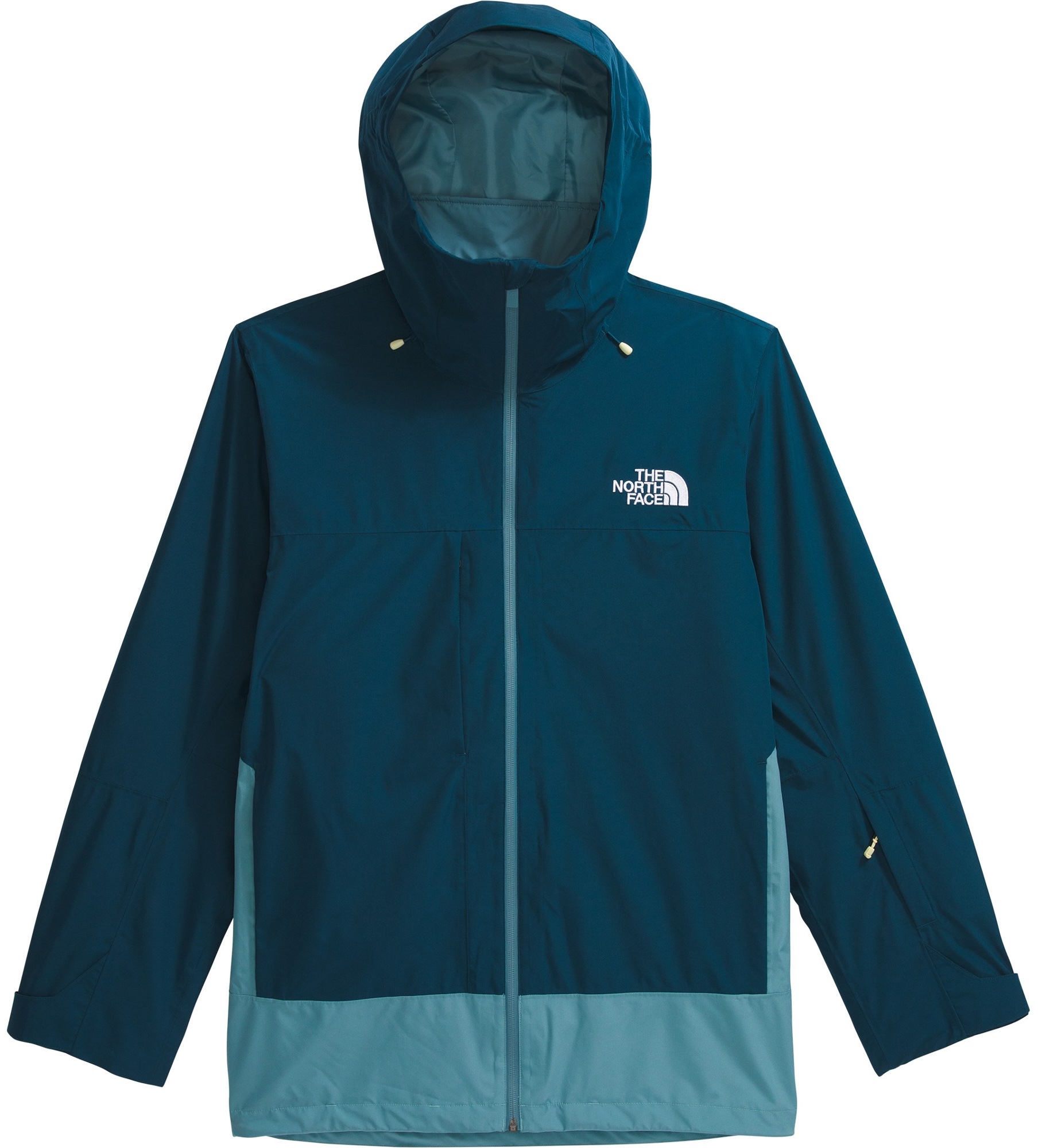 Category: 3-in-1
Category: 3-in-1
Insulation: 133g ThermoBall
Waterproofing: 2L DryVent
What we like: Another great 3-in-1 snowboard jacket.
What we don’t: Pricier than 686 Smarty Form/Spellbound above without enough to show for it.
Last but not least is The North Face's ThermoBall Snow Triclimate Jacket, which joins the 686 Smarty Form and women's Spellbound above as a 3-in-1 option for new and occasional riders looking for the convenience of an all-in-one purchase. With thick (133g) ThermoBall insulation packed inside a 2-layer DryVent shell, the Triclimate is well suited for fending off cold and harsh weather. It also comes decked-out in the features department with healthy storage inside and out, an adjustable hood that's helmet-friendly, underarm vents, and a powder skirt. Finally, it's worth noting that TNF's ThermoBall insulation does a pretty nice impression of down, making the midlayer a quality piece in its own right.
The ThermoBall was in the running for our 3-in-1 title, but the 686 Smarty Form and women's Spellbound offer similar performance for $100 less. This alone was enough to push the ThermoBall down in our rankings, but we're also miffed by some of the design differences between the men's and women's styles: The men's version has a stylish, freeride-inspired cut, while the women's is decidedly athletic and uninspired. On the flip side, we like the women's midlayer more because it features full-length baffling, while the men's is only baffled around the core, giving in an unfinished look. To be sure, the ThermoBall Triclimate Jacket is deserving of its popularity, but we think most folks will be fine saving with the 686 above.
See the Men's TNF ThermoBall Snow Triclimate See the Women's TNF ThermoBall Triclimate
| Snowboard Jacket | Price | Category | Insulation | Waterproof | Seam Sealing |
|---|---|---|---|---|---|
| Burton [ak] Swash Gore-Tex 2L | $500 | Insulated | 60g PrimaLoft | 2L Gore-Tex | Fully taped |
| Burton Covert 2.0 Insulated | $270 | Insulated | 80g Thermacore | 2L Dryride | Critically taped |
| Arc’teryx Sabre Jacket | $750 | Shell | None (flannel liner) | 3L Gore-Tex ePE | Fully taped |
| 686 Smarty 3-in-1 Form | $300 | 3-in-1 | 160g InfiLoft | 2L InfiDry | Fully taped |
| Patagonia Insulated Powder Town | $399 | Insulated | 80g / 40g | 2L H2No | Fully taped |
| Trew Gear Cosmic Primo | $499 | Shell | None | 3L PNW Primo | Fully taped |
| Volcom L Insulated Gore-Tex | $395 | Insulated | 80g / 60g | 2L Gore-Tex | Fully taped |
| Flylow Gear Albert Jacket | $450 | Insulated | 60g Greenloft | 2L Lux | Fully taped |
| Trew Gear Jefferson Jacket | $329 | Shell | None | 2L PNW | Fully taped |
| OR Hemispheres II Gore-Tex | $649 | Shell | None | 3L & 2L Gore-Tex | Fully taped |
| REI Co-op First Chair GTX | $319 | Shell | None | 2L Gore-Tex ePE | Fully taped |
| TNF ThermoBall Snow Triclimate | $400 | 3-in-1 | 133g ThermoBall | 2L DryVent | Fully taped |
| Snowboard Jacket | Price | Category | Insulation | Waterproof | Seam Sealing |
|---|---|---|---|---|---|
| Burton [ak] Embark Gore-Tex 2L | $500 | Insulated | 60g PrimaLoft | 2L Gore-Tex | Fully taped |
| 686 Athena Insulated | $200 | Insulated | 80g / 60g / 40g | 2L infidry | Critically taped |
| Arc’teryx Sentinel Jacket | $750 | Shell | None | 3L Gore-Tex ePE | Fully taped |
| 686 Smarty 3-in-1 Spellbound | $300 | 3-in-1 | 100g InfiLoft | 2L InfiDry | Fully taped |
| Patagonia Insulated Powder Town | $399 | Insulated | 80g / 40g | 2L H2No | Fully taped |
| Trew Gear Stella Primo | $499 | Shell | None | 3L PNW Primo | Fully taped |
| Flylow Gear Avery Jacket | $315 | Insulated | 100g / 80g | 2L Lux | Fully taped |
| Burton Prowess 2.0 Jacket | $300 | Insulated | 60g Thermacore | 2L DryRide | Critically taped |
| Trew Gear Astoria Jacket | $329 | Shell | None | 2L PNW | Fully taped |
| OR Hemispheres II Gore-Tex | $649 | Shell | None | 3L & 2L Gore-Tex | Fully taped |
| REI Co-op First Chair GTX | $319 | Shell | None | 2L Gore-Tex ePE | Fully taped |
| TNF ThermoBall Snow Triclimate | $400 | Insulated | 133g ThermoBall | 2L DryVent | Fully taped |
Winter is our busy season at Switchback Travel, so we take ski and snowboard gear testing very seriously. Whether that means getting after it underneath the chairlift or earning our turns in the backcountry, having gear we can trust is a big part of maximizing enjoyment on the slopes. Former editor-in-chief John Ellings and former senior editor Jenny Abegg, who bring decades of outdoor gear testing experience to the table, worked together to kick off this guide in 2020 with a handful of carefully considered picks. Based in central Washington, John and Jenny are no strangers to deep powder, heavy rain, and everything in between. Editor Maddie Downie took over our snowboard jacket coverage in 2024. With a background in both skiing and snowboarding, Maddie is very in tune with the snow apparel market and fills in the gaps by leveraging an extensive network of testers and gear-savvy contributors, many of whom are featured in the photos throughout this guide.
Our lineup of 14 snowboard jackets above is the result of countless hours of on-snow testing, lots of research into the current landscape, and feedback from our readers and the wider snowboard community. Testing these pieces involves a lot of analysis: We look closely at the materials and components used, evaluating how everything holds up in inclement weather and over the long term, from the waterproof membrane to the zippers and drawcords. We also make note of fit and layering ability, scrutinize breathability by hoofing it into the sidecountry or up the skin track, and consider factors like weight and packability in the case of backcountry-focused designs. We also take sustainability into account, prioritizing pieces that are made with recycled materials, PFAS-free DWR coatings, and more. As the market continues to evolve, we'll be sure to keep our picks above fresh based on our ongoing testing.

Shell
Snowboard jackets generally fall into three main categories: non-insulated shells, insulated models with synthetic or down fill, and 3-in-1 designs. Shell jackets are the most versatile option for season-long use. Without built-in insulation, they allow you to fine-tune your layering based on weather conditions—wear a lightweight layer on mild days or add a thick midlayer for extra warmth in colder temperatures. Premium shells are also ideal for sidecountry and splitboarding due to their superior breathability, reducing the risk of overheating. The primary drawback of a shell is cost: Since they don’t provide much warmth on their own, you’ll need to invest in an insulating layer. Top-rated shell options include the Arc’teryx Sabre/women's Sentinel and Trew Gear Cosmic Primo/women's Stella Primo.
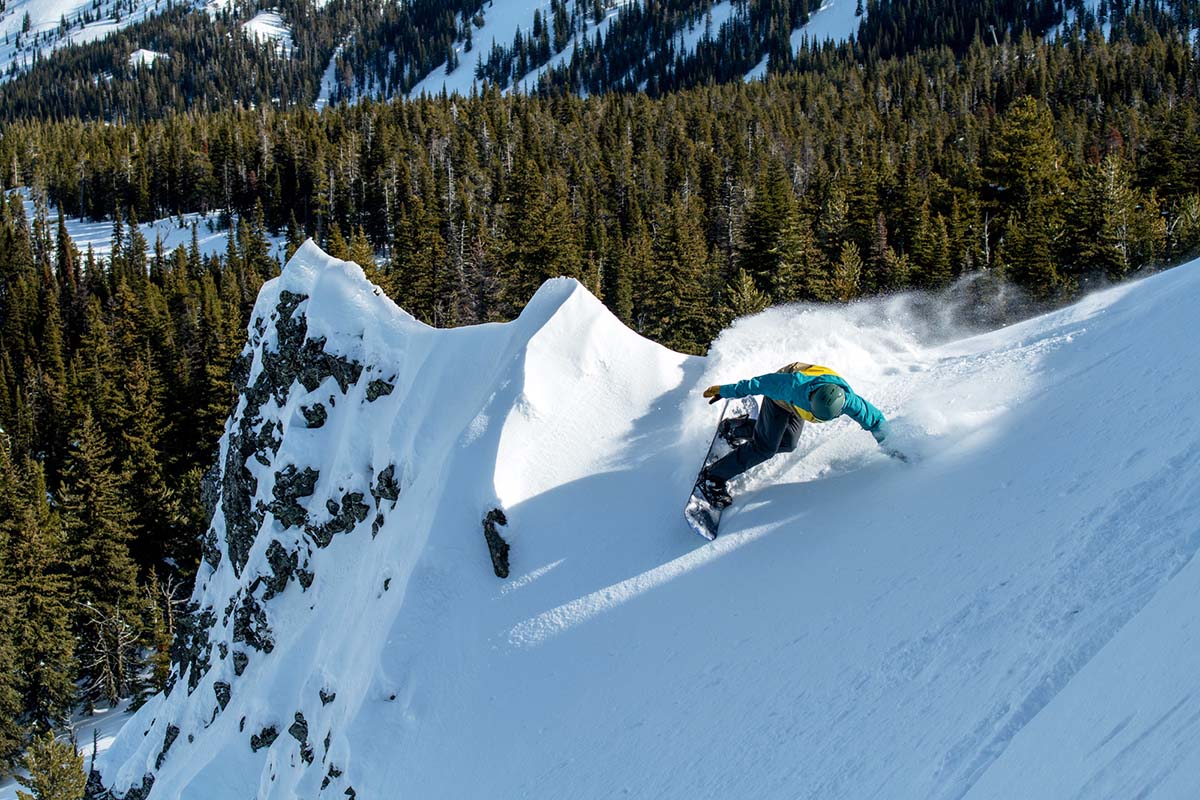
Insulated
As the name suggests, these jackets incorporate insulation between the outer shell and inner lining to provide extra warmth on the slopes. Most models use synthetic insulation because it’s cost-effective and continues to insulate even when wet (unlike down). Insulated jackets are particularly useful for riders who run cold or frequent colder regions like the Northeast or high-elevation areas in the Rockies. However, they can lead to overheating on mild days or during hikes, making a shell a better option for those scenarios. Some of our favorite insulated snowboard jackets include the Burton [ak] Swash Gore-Tex 2L and women's Embark, Patagonia’s Insulated Powder Town, Flylow Gear’s Albert and women's Avery.

3-in-1
These jackets include a waterproof outer shell and an insulating layer that can be zipped in or out, allowing for adaptable use depending on the conditions. 3-in-1 designs typically fall on the budget-friendly end of the spectrum, ranging from $200 to $400, making them a popular choice for beginners and casual riders.
However, there are some compromises. The additional zippers and buttons add extra weight, making these jackets the heaviest and bulkiest option. Insulating efficiency is also lower, and these models can be drafty in harsh weather. Additionally, the zip-out layers tend to be of lower quality, often lacking key features like adjustable hems, leading to an awkward fit when worn separately. In the end, while 3-in-1s like the 686 Smarty Form and women's Spellbound ($300) represent a solid value, it’s important to be aware of these trade-offs.

Given the stop-and-start nature of snowboarding—waiting on lifts, strapping in and out of bindings, and spending time in the terrain park—many resort riders opt for jackets with insulation. The level of warmth varies between models, so consider how much insulation you actually need. If you tend to feel cold or frequently ride in frigid conditions, a well-insulated jacket makes sense. However, if you run warm or ride in fluctuating temperatures (like the Pacific Northwest), opting for light insulation or a shell is the better choice. It’s easier to layer up for warmth than to cool down when overheating, which can also lead to fogged goggles and excessive sweat buildup.
Most snowboard jackets use synthetic insulation, measured in grams per square meter (g/m², often abbreviated to just "g"). While material quality impacts insulation effectiveness, you can make general assumptions based on fill weight. Jackets with 40g to 60g insulation provide lightweight warmth but usually require a midlayer in colder conditions. This level of insulation works well for milder weather or occasional sidecountry hikes. Stepping up to 80g to 100g insulation allows riders to forgo a midlayer in all but the coldest conditions. Many designs also include thicker insulation around the core while keeping the sleeves thinner to maintain warmth while maximizing mobility.

Construction
All the jackets that made our list provide protection against snow and wind, but their waterproofing effectiveness varies. Three factors influence this: the quality of the waterproof membrane, the durable water-repellent (DWR) coating, and seam taping. For top-tier waterproofing, Gore-Tex remains the gold standard, offering reliable wind and water protection in both 2-layer and more breathable 3-layer constructions. Many brands use proprietary alternatives, such as Patagonia’s H2No and Flylow Gear’s Intuitive, which perform well but are typically less durable than Gore-Tex. Budget-friendly jackets in the $200 to $300 range use lower-end waterproofing, which works fine in moderate conditions but may struggle in extended wet weather. For more details on 2- and 3-layer construction, see our breakdown on ski jacket construction (snowboard jackets are built the same way).

Durable Water-Repellent (DWR) Finish
DWR coatings help prevent the outer face fabric of a jacket from absorbing moisture, allowing water to bead and roll off rather than soaking in. This protects the inner waterproof membrane, preserving breathability and preventing leaks. A well-functioning DWR treatment makes snow and water easy to brush off with a glove. Lower-end snowboard jackets (under around $200) often lack a DWR coating, which is why we recommend investing in a higher-end model—especially for riders in wet-snow regions like the Pacific Northwest.
Seam Taping
Seam taping reinforces a jacket’s waterproofing by sealing potential entry points for moisture. Mid- and high-end models feature fully taped seams, while many budget options like the Burton Covert 2.0 and 686 Athena Insulated only tape the critical seams, such as the shoulders and front zipper. The quality of seam taping also varies—Arc’teryx, for example, is known for lightweight yet highly durable seam sealing. Cheaper versions may peel or deteriorate over time.

For most resort riders, breathability isn’t a top concern. As long as you choose an appropriate insulation level and stick to groomed runs or short tree runs, most jackets provide sufficient airflow. However, if you hike to access sidecountry terrain or engage in splitboarding, breathability becomes a much higher priority.
Among waterproof options, 3-layer non-insulated shells offer the best breathability by efficiently wicking moisture. Jackets like the Arc’teryx Sabre and women's Sentinel, which use 3-layer Gore-Tex, do an excellent job keeping riders comfortable during high-exertion activities. For the most breathability—ideal for spring splitboarding—a non-waterproof softshell is also an option. However, softshells trade off waterproofing for airflow, making them less practical for season-long use.
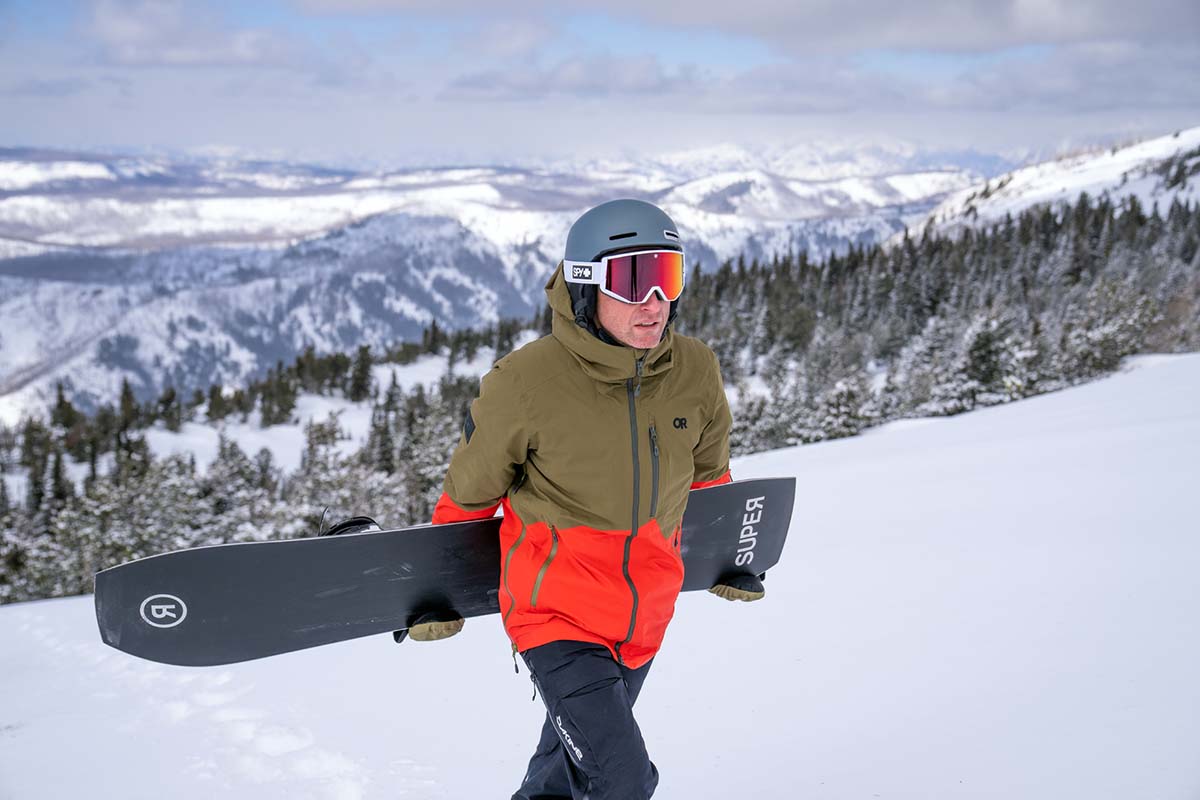
Snowboard jackets frequently advertise two key metrics: waterproof and breathability ratings. Waterproof ratings (measured in millimeters) use a static-column test, where fabric is placed under a 1-inch-diameter tube and water is added until leakage occurs. The height of the water column before leaking determines the rating. Breathability ratings (measured in grams) indicate how much water vapor escapes through the fabric over 24 hours.
However, these lab-based tests don’t perfectly replicate real-world conditions, so we don’t recommend relying solely on them. Breathability ratings, in particular, lack standardized testing methods. There isn’t an established procedure to compare products, and the test is done in a controlled lab environment (in other words, not out in the snow). There is some value in the static-column rating—a higher number will typically lead to better waterproofing—but plenty of other factors come into play, including DWR coating, fabric denier, and seam taping. Instead, a good rule of thumb is that higher-end jackets (such as those with Gore-Tex) provide better waterproofing, while uninsulated shells offer superior breathability.

Snowboard jackets are designed to handle harsh conditions, featuring durable outer fabrics that withstand chairlift wear, terrain park abuse, and exposure to sharp gear. Unlike rain and hardshell jackets, snowboard jacket manufacturers rarely list fabric denier (a measure of thickness), making it difficult to compare durability at a glance. However, some general trends apply: Budget jackets tend to use thicker materials for weatherproofing, while mid-range options like Volcom’s L Gore-Tex use higher-end fabrics that balance durability and weight. Technical shells and backcountry-oriented jackets prioritize lighter materials for improved mobility and breathability, but models like the Trew Gear Cosmic Primo/women's Stella Primo and Arc’teryx Sabre/women's Sentinel remain impressively tough despite their lighter builds.

Closely linked to durability, weight may or may not play a role in your buying decision but is worth considering as part of the larger picture. Heavier jackets tend to be more rugged and durable, while lighter models prioritize mobility. Weight also correlates with jacket type: Shells are the lightest, insulated models sit in the middle, and 3-in-1s are typically the heaviest due to their multi-layer construction.
For most resort riders, weight isn’t a major concern. While reducing bulk can improve comfort (one of our main complaints about 3-in-1 designs), many snowboarders are content with a moderately heavy jacket. In fact, most brands don’t even list weight specs since it’s not a primary comparison factor. However, for those venturing into the backcountry or spending time off trail, a lighter shell enhances mobility and all-day comfort. Jackets like the Arc’teryx Sabre and women's Sentinel excel in this area, offering robust weather protection while feeling nearly weightless during use.
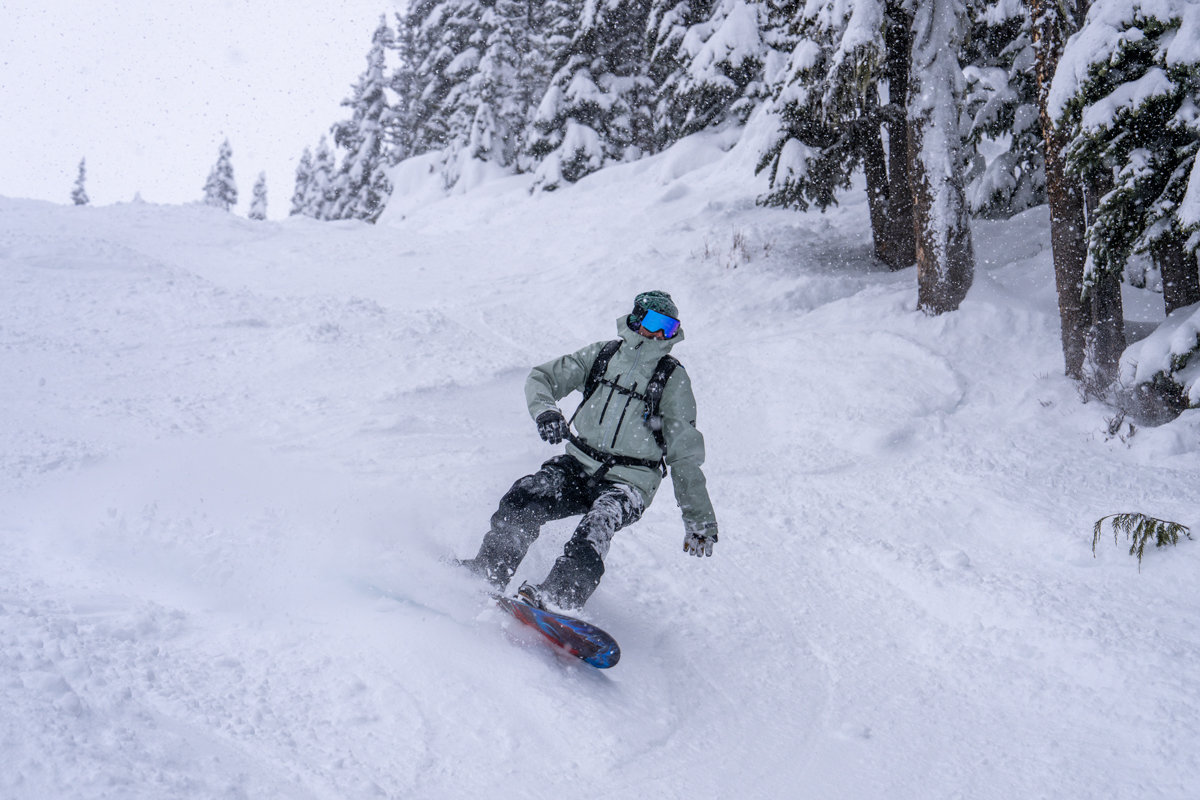
Snowboard jackets are traditionally known for their relaxed and slightly baggy fits, though more brands are now offering trimmer cuts to reduce excess bulk. Park riders often prefer a looser fit for unrestricted movement (and style plays a role here too), whereas those who explore sidecountry terrain tend to opt for a more streamlined silhouette, often labeled as “standard” or “regular” fit.
When selecting a jacket, it’s essential to consider layering. If you plan to wear thick midlayers, ensure there’s enough room to accommodate them without restricting movement. Additionally, back length is an important factor: Most snowboard jackets provide sufficient coverage for sitting on lifts or in the snow, but some park-specific models can be excessively long, while dedicated backcountry shells may be too short for resort use.
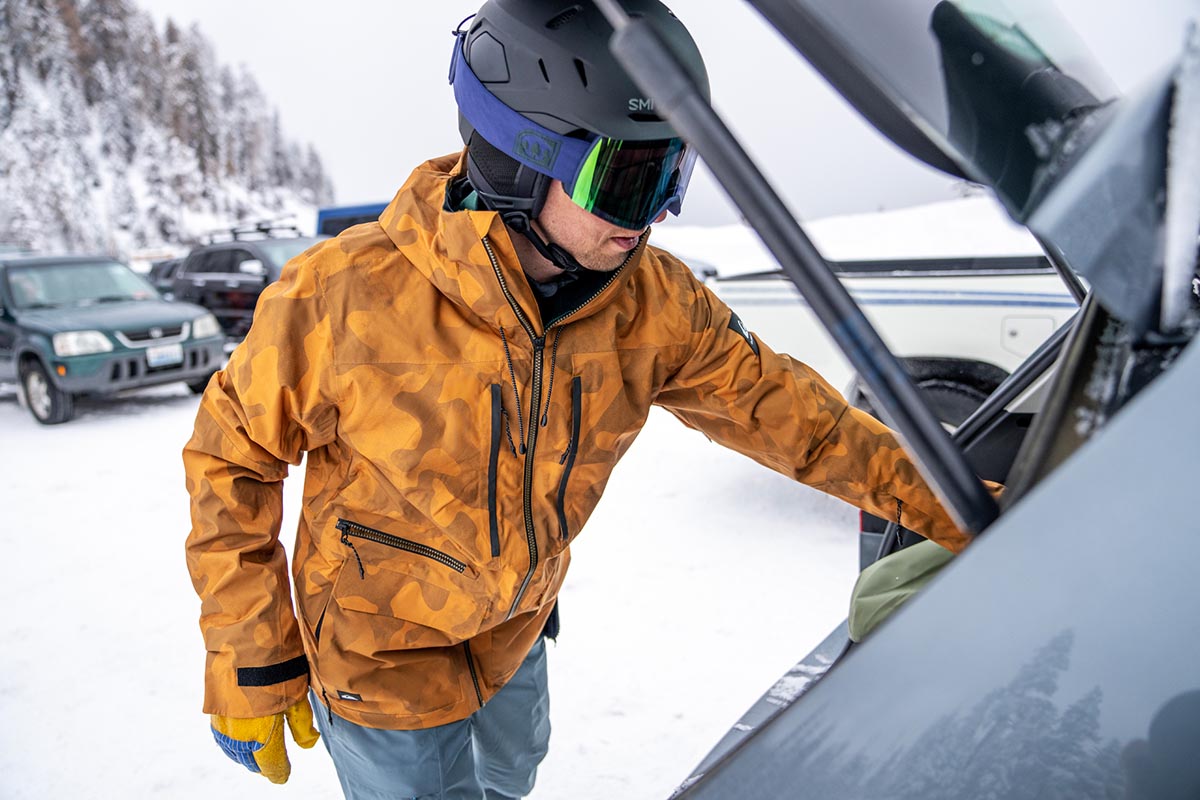
Hood
For protection against strong winds and heavy snowfall, a helmet-compatible hood is a key feature in a snowboard jacket. Higher-end models generally offer better hood designs, with improved adjustability for a secure fit, better coverage to minimize exposed skin, and structured brims that help keep snow off your goggles. Budget-friendly jackets often lack some refinement, making it harder to achieve a snug and protective fit. Our favorite hood design is Arc'teryx's venerable StormHood, but we also like Burton's [ak] series, many of Patagonia's offerings (including the Powder Town), and Volcom's L Gore-Tex.

Pockets and Organization
Most snowboard jackets include a variety of pockets, though some designs offer more functional storage than others. Chest-height pockets are great for quick access to essentials like a phone or wallet. Some designs even feature insulated media pockets to minimize battery drainage in the cold (Burton’s Therma-Pocket is one example). Handwarmer pockets are useful for keeping gloved hands warm, and those with an RFID pass will appreciate an exterior pocket on the left sleeve for easy scanning. For backcountry riders, large interior drop-in pockets are excellent for storing goggles, gloves or mittens, or splitboard skins.

Pit Zips (Underarm Vents)
Pit zips are a valuable but often overlooked feature. You may go days without using them, but when temperatures rise, you hit the sidecountry, or you’ve layered too much, opening these vents provides instant relief. Pit zip designs vary, with some featuring a mesh lining to keep out blowing snow, though this slightly reduces airflow. Regardless of the specific design, we consider underarm vents a must-have, and nearly all of our recommended jackets include them.

Powder Skirt
A powder skirt (or waist gaiter) is designed to keep snow from entering your jacket when riding in deep conditions or after a fall. These skirts typically fasten with buttons at the front and sit above the hemline. While not essential for all conditions—a snug hem cinch and extended back length usually suffice for resort riding—powder skirts add an extra layer of security against snow intrusion. Some riders find them cumbersome when left unbuttoned, in which case it could be worth looking for a detachable design that can be removed on mild days.

Jacket-to-Pant Attachment System
Similar to a powder skirt, jacket-to-pant attachment systems help seal out snow and trap warmth. These vary in design, ranging from simple button attachments (like Patagonia’s) to zippered interfaces that create a near-seamless barrier against the elements (such as Volcom’s Zip Tech system). While not essential, these systems are popular among riders who frequently ride in deep snow or take frequent falls. Keep in mind that these interfaces generally require snowboard pant from the same brand to function properly.
Recco
Many mid-range and high-end snowboard jackets come equipped with Recco reflectors. These passive, battery-free units can be detected by Recco search-and-rescue equipment, offering an added safety measure for riders venturing off trail or beyond the ropes. While not a substitute for an avalanche beacon, Recco reflectors provide an additional layer of assurance. More information on the technology can be found on the Recco system website.
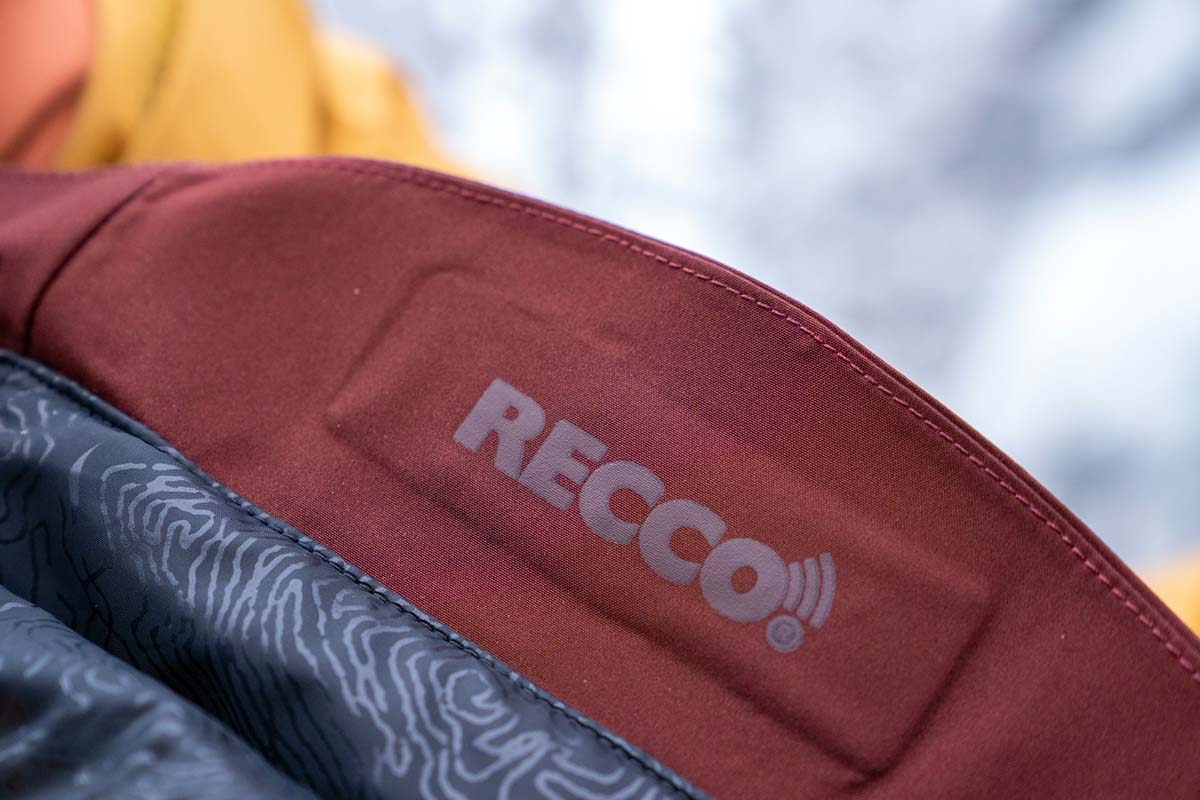
Sustainability has become a key focus in the snowboard apparel market and beyond, with many leading brands adopting eco-friendly materials and production practices in recent years. Key measures include the use of recycled fabrics and PFAS-free DWR coatings (traditional coatings contain per- or polyfluorinated substances—commonly known as “forever chemicals”—which are known to be harmful to the environment). As more states move to ban PFAS, we appreciate that many outdoor brands are shifting to safer alternatives for water- and stain-resistant finishes.
Bluesign-approved fabrics are also becoming more widespread, ensuring that materials are produced with minimal environmental impact. Many brands also offer Fair Trade-certified products, ensuring ethical labor practices. Transparency has improved, with brands clearly labeling their sustainability initiatives. Patagonia has long been a leader in this space, but brands like Burton, REI Co-op, and Trew Gear have made notable inroads, too. While the industry still has progress to make, the momentum toward more responsible production practices is promising. Finally, one of the best ways to shop sustainably is by investing in high-quality gear that lasts and repairing old gear rather than replacing it frequently.
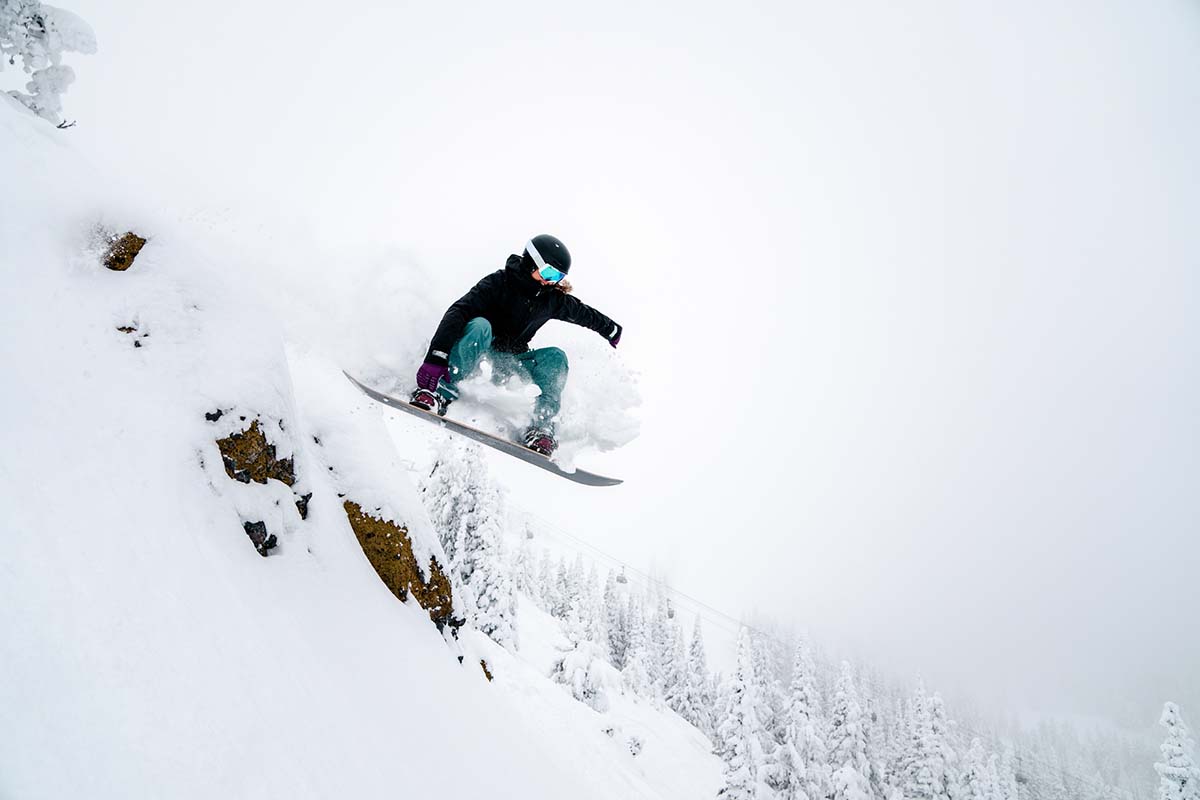
Due to the similarities between snowboarding and skiing, many jackets are designed to work for both sports. In fact, you’ll often see jackets labeled as suitable for both activities on manufacturer and retailer websites. Brands like Patagonia and Arc’teryx explicitly state that their designs cater to both skiers and snowboarders.
However, there are some subtle differences. Snowboard jackets typically have a looser fit to allow unrestricted movement. They also tend to feature longer back lengths for better coverage, which is helpful since snowboarders frequently sit on the snow while strapping in. Additionally, many snowboarders prefer mittens over gloves, so snowboard jackets often have larger zipper pulls for easier handling. These differences may or may not impact your decision, but we've found that many snowboarders are perfectly comfortable wearing a ski-specific jacket. For a full look at the market, check out our article on the best ski jackets.
Back to Our Snowboard Jacket Picks Back to Our Jacket Comparison Tables